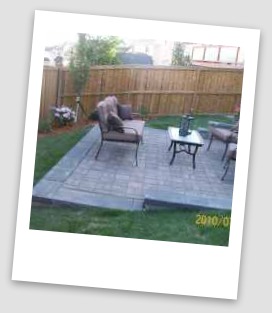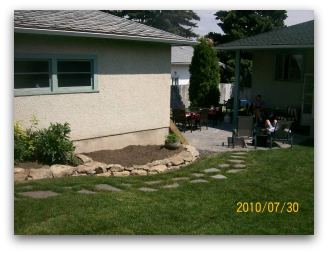F. Sodding Completion
and Clean-up
Sodding completion is the last section in this module where we cover the
final steps to complete the job. We will also be covering ongoing care
for your new lawn.
Sodding completion is the last section in this module where we cover the final steps to complete the job.
We will also be covering ongoing care for your new lawn.
Rolling the lawn
Now that you have finished laying all the sod, you can use a barrel roller.
Fill the barrel with water 1/3 to 1/2 full, and roll in strips to make sure you have effective coverage.
This is done to ensure good root contact from the bottom of the sod, to the soil underneath. This will also help by removing any air pockets that may exist under the sod.
Watering new sod
When sod is harvested, the roots are almost completely cut off. This is why it is so important to have good sod to soil contact. Proper watering will now help with re-establishment of the roots into the soil.
Rather then giving you a schedule for watering sod, we think you should understand why, and when it needs it. This means that it will receive only what it needs.

Always give your new lawn a good initial soaking after it is laid down. This will help the sod recover from the transplant while the roots drop into the soil faster.
Watering sod after it is laid down also helps prevent shrinking and gaps from the sod as it dries out.
Newly sodded yards require more water than established lawns. It takes a couple of weeks for the roots to fully drop into the new soil underneath.
Water once a day for the first three to four days, then skip a couple of days. Give the soil a chance to dry up just a little to prevent drowning the sod. This is also beneficial as it encourages the roots to grow deeper into the soil.
The second week try to water every other day or so. Taking a couple of days off at the end of the second week. You may also need to mow between week one and two.
By week three you should back off to watering once a week unless it is hot and dry. In this case it may require water two to three times a week.
As you can see, it has nothing to do with a schedule at all. The success depends on you being in tune to the daily requirements of your lawn. This is affected by the wind, sun, rain, and retention abilities of your soil type.
Avoid "Runoff"
Always water deeply, but not to the point of it running down off the grass and into the city drains. This is a waste of water. It is referred to as "Runoff". This is a big problem for clay, and heavily compacted soils. Move the sprinkler around in 15 minute intervals if you have too. You can come back to finish sections that haven't been watered deeply enough.
Try to water to a depth of about six inches. Water in the early morning before the intense sun and heat appear. Watering in the day is pointless if it's hot or windy. The water will be lost by evaporation.
These are basic guides only. You should be watering less if you are getting rain, and more if it is very hot and dry.
It's up to you to use your best judgement.
If you are unsure of the amount of water you are getting, peel back a piece of sod. Use your finger or small tool, and dig down to check the depth of water saturation in the soil.
It is possible that mushrooms can appear in your newly laid sod. After all, you have given them an ideal conditions to grow. They should die off once your lawn is established and you back off on your watering.
After a month or so your lawn should be a little more established, and you can visit our module on lawn care and maintenance for more sod care tips.
Top dressing a lawn
You probably noticed that you don't have a perfectly flat lawn, although it looks pretty good just the same. For those of you that want that perfect lawn, you should consider topdressing. It's a good idea to let the newly laid sod establish a good strong root system first.
Topdressing is just spreading a thin layer of rich loam or compost over your lawn. It will also fill in small depressions to get the height of your whole lawn more flat. It is also a great way to improve your soil composition, and organics help to keep thatch under control.
It can sometimes take a few years to achieve a perfect lawn. If you end up with a sinkhole for whatever reason, make sure you don't put down more than an inch or two at a time. Grass will generally grow through anything up to a couple of inches thick, after that, you risk killing it. In other words, be patient and build it up in layers.
Cleaning up the area not only means your yard, but the street in front of you house as well, if you made a mess there too. If you have extra loam, keep a small pile aside for topdressing or sinkholes that may appear from settling. Any extra soil can probably be given to someone close by putting a small sign in your yard.

Congratulations, you are now finished your sodding project. Kick back in a nice lawn chair and enjoy all your hard work. It's a great feeling isn't it? The pride, satisfaction, and joy of doing it yourself is amazing. Not to mention the fact that you have just added value to you property.
I really hope you found this information useful? If you did please feel free to tell us about it and don't forget to send us pictures of your beautiful yard. If there is anything you feel we can improve on please let us know that as well. We can only improve with your feedback. Don't forget to pass this site on to your family, friends, or neighbors.
Some helpful videos:
Preparing and Amending Soil Video
Sodding Installation Video
Recommended Sites:
Complete Lawn Care advice - Lawn Care Tips, Zoysia, Fescue, Fertilization
Scotts
American Lawns
_____________________________________
Table of Contents: Sodding a Lawn
A. Sod Site
C. Selecting and Estimating Sodding Materials
E. Laying Sod
F. Sodding Completion and Clean-up
______________________________________
Return to Dream Yard Home Page from Sodding Completion
Check out our time and money saving e-book
How to avoid the biggest mistakes made by DIYers, designers, and landscaping companies.
Visitor
Favorites
Giggles 'n' Thoughts





